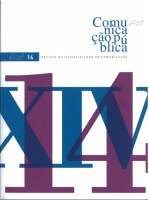Partisan websites, an empirical study compared on the functionality
DOI:
https://doi.org/10.4000/cp.558Keywords:
websites, political parties, functionalityAbstract
The internet from the years 1990 becomes accessible to the majority of political parties in the world. In this sense, this tool brings a number of advantages through its hyperlinks, how to increase the amount of information flows, as well as to cultivate participation. To this end, we apply the methodology proposed by Barnett et al (2009) and Iasulaitis (2007), to measure and compare the functionality of partisan websites. The results indicate that: 1) most parties of Paraná has no website; 2) all websites analyzed have low functionality; and 3) privileged parties plus the site as an information tool and less as a communication channel.
Downloads
References
Ackland, R., e Gibson, R. (2004, abril), “Mapping political party networks on the WWW”, in Australian Electronic Governance Conference, pp. 14-15.
Barros, A. D. J. P., e Lehfeld, N. A. (2012), Projeto de Pesquisa: Propostas Metodológicas, Vozes.
Braga, S. S., Nicolás, M. A, e França, A. S. T. (2009), “Os partidos brasileiros e a internet, uma avaliação dos websites dos partidos políticos do Brasil”, Revista de Sociologia e Política, 17(34), pp. 183-208. DOI : 10.1590/S0104-44782009000300013 good / bad
Brown, R. (2009), Public Relations and the Social Web: How to Use Social Media and Web 2.0 in Communications, Kogan Page.
Conway, M., e Dorner, D. (2004), “An evaluation of New Zealand political party websites”, Information Research, 9(4), pp. 9-4.
Haythornthwaite, C. (2007), “Social networks and online community”, The Oxford Handbook of internet Psychology, pp. 121-137. DOI : 10.1093/oxfordhb/9780199561803.013.0009 good / bad
Iasulaitis, S. (2006), “A internet pode revigorar as eleições? Um estudo das campanhas virtuais presidenciais do pleito de 2006”, Encontro anual da ANPOCS, 31.
Loader, B. (ed.) (2007), Young Citizens in the Digital Age: Political Engagement, Young People and New Media, Psychology Press.
Norris, P. (2003), “Preaching to the converted? Pluralism, participation and party websites”, Party Politics, 9(1), pp. 21-45. DOI : 10.1177/135406880391003 good / bad
O’Reilly, T. (2007), “What is Web 2.0: Design patterns and business models for the next generation of software”, Communications & Strategies, (1), 17.
Park, H. W. (2003), “Hyperlink network analysis: A new method for the study of social structure on the web”, Connections, 25(1), pp. 49-61.
Petricek, V., Escher, T., Cox, I. J., e Margetts, H. (2006), “The web structure of e-government-developing a methodology for quantitative evaluation”, in Proceedings of the 15th International Conference on World Wide Web, pp. 669-678, ACM.
Schumpeter. J. A. (1961), Capitalismo, Socialismo e Democracia, Rio de Janeiro, Editora Fundo de Cultura.
Schweitzer, E. J. (2005), “Election Campaigning Online German Party Websites in the 2002 National Elections”, European Journal of Communication, 20(3), pp. 327-351. DOI : 10.1177/0267323105055261 good / bad
Small, T. A. (2008), “Equal access, unequal success—major and minor Canadian parties on the net”, Party Politics, 14(1), pp. 51-70. DOI : 10.1177/1354068807083823 good / bad
Downloads
Published
Issue
Section
License
Copyright (c) 2013 Direitos do Autor (c) 2013

This work is licensed under a Creative Commons Attribution-NonCommercial 4.0 International License.
Os conteúdos da Comunicação Pública estão licenciados com uma licença Creative Commons - Atribuição-NãoComercial 4.0 Internacional.


